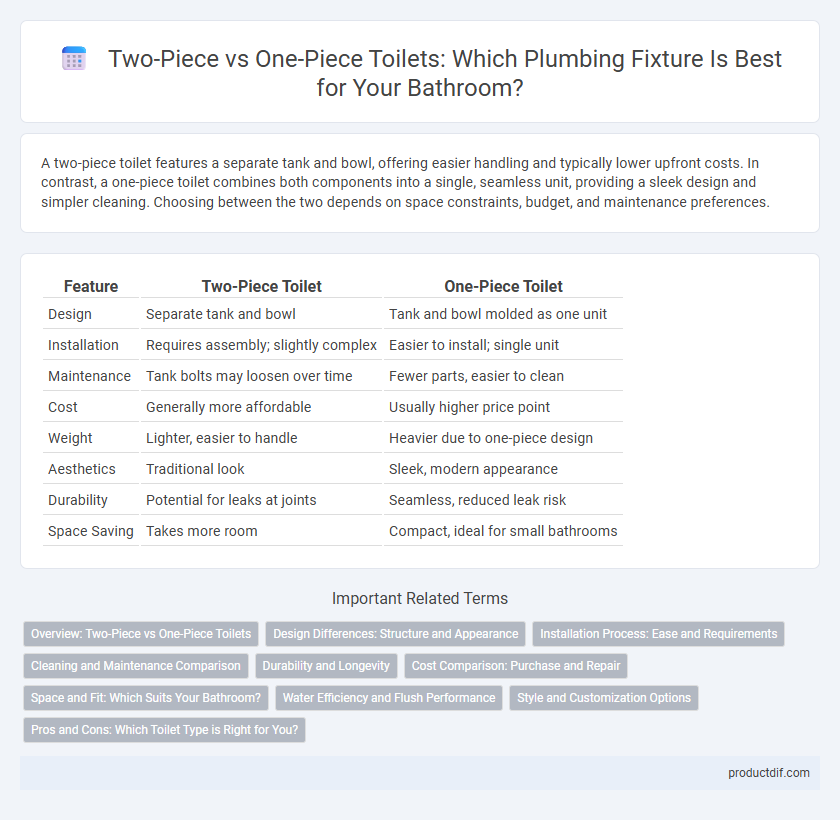A two-piece toilet features a separate tank and bowl, offering easier handling and typically lower upfront costs. In contrast, a one-piece toilet combines both components into a single, seamless unit, providing a sleek design and simpler cleaning. Choosing between the two depends on space constraints, budget, and maintenance preferences.
Table of Comparison
| Feature | Two-Piece Toilet | One-Piece Toilet |
|---|---|---|
| Design | Separate tank and bowl | Tank and bowl molded as one unit |
| Installation | Requires assembly; slightly complex | Easier to install; single unit |
| Maintenance | Tank bolts may loosen over time | Fewer parts, easier to clean |
| Cost | Generally more affordable | Usually higher price point |
| Weight | Lighter, easier to handle | Heavier due to one-piece design |
| Aesthetics | Traditional look | Sleek, modern appearance |
| Durability | Potential for leaks at joints | Seamless, reduced leak risk |
| Space Saving | Takes more room | Compact, ideal for small bathrooms |
Overview: Two-Piece vs One-Piece Toilets
Two-piece toilets feature a separate tank and bowl, offering easier repairs and typically lower upfront costs, while one-piece toilets integrate the tank and bowl into a single unit, providing a sleeker design and simpler cleaning. Two-piece models are more common and generally easier to replace components, whereas one-piece toilets often have improved durability and modern aesthetics. Choosing between the two depends on bathroom design preferences, budget, and maintenance considerations.
Design Differences: Structure and Appearance
A two-piece toilet consists of a separate tank and bowl joined during installation, offering easier transport and replacement of parts. One-piece toilets integrate the tank and bowl into a seamless, compact unit, providing a sleek and modern appearance with fewer crevices for dirt buildup. The structural difference impacts both aesthetics and maintenance, with one-piece models often preferred for contemporary bathroom designs due to their smooth contours and streamlined look.
Installation Process: Ease and Requirements
Two-piece toilets typically require more time and effort to install due to separate tank and bowl components that must be securely connected, often necessitating additional tools and adjustments. One-piece toilets offer a streamlined installation process with fewer parts, reducing the risk of leaks and simplifying the alignment and sealing steps. Homeowners or plumbers prefer one-piece models when seeking quicker installation and minimal maintenance challenges.
Cleaning and Maintenance Comparison
Two-piece toilets consist of a separate tank and bowl, making them easier to disassemble for deep cleaning and repairs, but their crevices can accumulate more dirt and grime. One-piece toilets feature a seamless design that prevents dirt buildup and simplifies daily cleaning, reducing maintenance time. However, one-piece models can be heavier and more challenging to maneuver during extensive repairs or replacements.
Durability and Longevity
Two-piece toilets feature a separate tank and bowl, making them easier to transport and repair, but the connection joint may be prone to leaks over time, potentially reducing durability. One-piece toilets are molded as a single unit, eliminating seams that can weaken, resulting in enhanced structural integrity and longer lifespan. High-quality materials and design in one-piece models generally contribute to superior resistance against wear and corrosion compared to two-piece alternatives.
Cost Comparison: Purchase and Repair
Two-piece toilets generally have a lower initial purchase cost compared to one-piece models, making them a budget-friendly option for homeowners. Repair costs for two-piece toilets can be higher due to separate tank and bowl components, which may require more frequent part replacements or specialized labor. One-piece toilets, while initially more expensive, often incur lower repair costs because their integrated design reduces the likelihood of leaks and component failures.
Space and Fit: Which Suits Your Bathroom?
Two-piece toilets feature separate tanks and bowls, offering more flexibility in tight or irregular bathroom spaces due to easier maneuvering during installation. One-piece toilets have a compact design with a seamless structure that fits well in small bathrooms, providing a sleeker look and making cleaning around the base simpler. Choosing between the two depends on bathroom size and layout, ensuring optimal space utilization and comfort.
Water Efficiency and Flush Performance
Two-piece toilets generally offer comparable water efficiency to one-piece models, often using 1.28 gallons per flush (GPF) to meet EPA WaterSense standards. One-piece toilets tend to deliver more powerful flush performance due to their integrated design, reducing clogs and improving waste removal. Both types provide water-saving technology, but one-piece toilets often optimize flush mechanics for enhanced efficiency and reliability.
Style and Customization Options
Two-piece toilets offer greater style versatility with a wide range of tank and bowl combinations, allowing homeowners to mix and match designs and finishes for a customized bathroom look. One-piece toilets feature sleek, seamless designs that create a modern and streamlined aesthetic but typically come in fewer style options. Customization in two-piece models extends to replacement parts and upgrades, while one-piece toilets emphasize uniformity and ease of cleaning over varied stylistic choices.
Pros and Cons: Which Toilet Type is Right for You?
Two-piece toilets offer easier handling during installation and generally lower upfront costs, but their multiple parts increase potential leak points and cleaning complexity. One-piece toilets provide a sleek design with fewer crevices, enhancing hygiene and simplifying maintenance, though they typically come with a higher price and added weight. Evaluating bathroom size, budget, and maintenance preferences helps determine if the durable, streamlined one-piece or the cost-effective, traditional two-piece toilet suits your plumbing needs best.
two-piece toilet vs one-piece toilet Infographic

 productdif.com
productdif.com